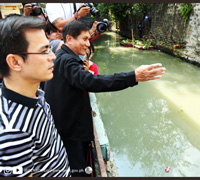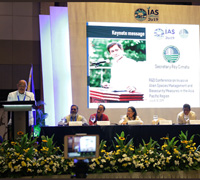Cimatu fetes art exhibit on Manila Bay rehab

Environment Secretary Roy A. Cimatu has lauded the efforts of the Dynamic Art Group for organizing an art exhibit in support of the ongoing rehabilitation of the highly polluted Manila Bay.
The exhibit, which ran from June 18 to July 27 at The Gallery of Solaire Resort and Casino in Parañaque City, features paintings of the historic bay during its glory days or long before the government decided to place it on rehabilitation due to serious environmental degradation.
“Through this exhibit, we are reminded about the glory of Manila Bay back during the days so that we may focus on the goal of sustaining the same thing for the next generations,” Cimatu said.
The paintings were created by artists Vic Bachoco, Esther Garcia, Maxi Ramos, Jun Rocha, August Santiago, Fernando Sena, Fritz Silorio, Bing Siochi, Ely Tablizo, and Myk Velasco.
DENR Undersecretary for Solid Waste Management and LGU Concerns Benny D. Antiporda, who delivered a speech during the opening of the exhibit, emphasized that cleaning Manila Bay also aims to clean the culture of the Filipino people.
“It is the next generation who will suffer with what we are doing, and that, we will not permit,” Antiporda said.
He added: “When we started this project, people thought we were crazy, and yet we succeeded [with Boracay]. And now, Boracay is too small of a project compared with Manila Bay. Now, if we will succeed here in Manila Bay, Manila Bay will be too small of a project if we clean up the whole country.”
Paintings that are displayed in the exhibit include the Manila Bay Yacht Club with the famous Manila Bay sunset and a portrait of Secretary Cimatu.
The Manila Bay rehabilitation was launched in January this year pursuant to President Rodrigo Roa Duterte’s directive.
In 2008, the Supreme Court issued a writ of continuing mandamus ordering the DENR and 12 other agencies to restore the waters of Manila Bay to Class SB level.
Class SB level classifies coastal and marine waters as safe for regular use by the public for activities such as bathing, swimming and skin diving. #
- Details
- Parent Category: News & Events
- Category: Press Releases




